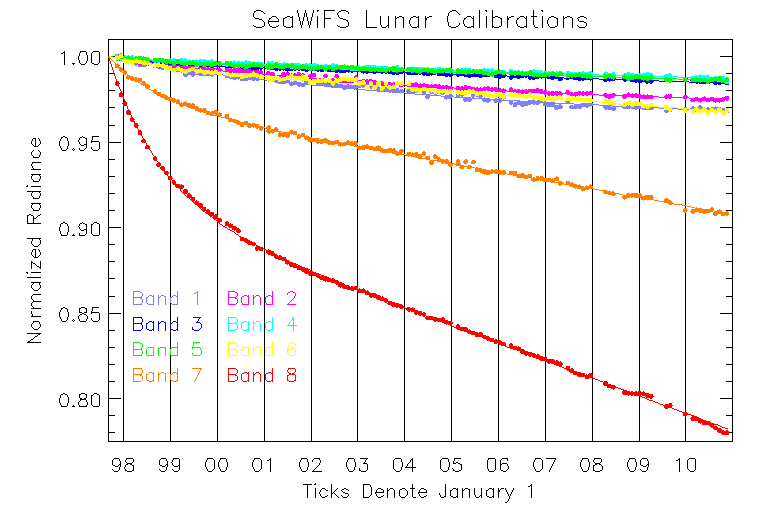ERROR @ Ocean Biology Distributed Active Archive Center (OB.DAAC)
.:. ERROR .:.
Ocean Biology Distributed Active Archive Center (OB.DAAC)
SeaWiFS Lunar Calibration Time Series

Image generated November 23, 2010, using 145 lunar cals collected through November 22, 2010.
The SeaWiFS lunar calibration time series, with the updated radiometric and temperature calibrations, is shown in the above figure. The fits to the time series, shown as the solid line for each band, were computed using the 140 lunar calibrations obtained through June 2010, prior to the satellite orbit raising maneuver. As of August 2010 two post-orbit raising calibration has been collected, which are consistent with the trend lines of the fits. This plot does not include the Gain 3 drift correction, since that correction only concerns the application of the radiometric calibration to the ocean data. As the SeaWiFS mission has gone on, the optimum fitting function for the time series has evolved due to extensive analyses of the behavior of all 8 bands. For bands 1-2, the current fits use simultaneous decaying exponential functions of time with time constants of 200 and 3200 days. For bands 3-8, the current fits use a decaying exponential function of time with a time constant of 400 days in conjunction with a linear function of time.

SeaWiFS Bands 1-4 These bands are plotted at on a higher resolution y-axis to show the behavior of the bands. Bands 1 and 2 use simultaneous exponentials as fitting functions. Bands 3 and 4 use an exponential and a linear function of time as fitting functions.

SeaWiFS Bands 5-6 These bands are plotted at on a higher resolution y-axis to show the behavior of the bands. Bands 5 and 6 use an exponential and a linear function of time as fitting functions.
Two different decay mechanisms are responsible for the changes in response of each of the bands. The first mechanism caused a rapid decrease in response that decayed away after approximately the first year of the mission. The second mechanism has been in effect over the entire mission. The long-period decay for the shorter wavelength bands (bands 1-4) most likely arises from yellowing of the instrument optics on orbit. The long-period decay for the longer wavelength bands (bands 5-8) most likely arises from charged-particle induced damage to the silicon photodiodes.
The SeaWiFS lunar calibration data have to be normalized to a common viewing geometry to produce the time series shown above. The U.S. Geological Survey ROLO (RObotic Lunar Observatory) photometric model of the Moon has been used to perform the geometric corrections for the Sun-Moon and instrument-Moon distances and for the phase and libration angles of the observations. In addition, the individual lunar images must be corrected for the oversampling of the lunar data during the lunar calibration maneuvers. The oversampling correction is computed by ratioing the measured size if the Moon in each lunar image with the actual size of the Moon at the time of the observations.
References
SeaWiFS / MODIS Lunar Cross Calibration
(Earth Observing Systems XIV, Proc SPIE 7452, 74520X 2009)
ROLO Lunar Photometric Model Paper
(Astron. J. 129, 2887-2901 2005)
SeaWiFS / ROLO Comparison
(Appl. Opt. 43, 5838-5854, 2004)
Lunar Calibration Methodology after Six Years on Orbit
(Earth Observing Systems IX, Proc SPIE 5542, 1-13, 2004)
Direct Calibration of SeaWiFS
(Appl. Opt. 40, 6682-6700, 2001)
Links of Interest
SeaWiFS Reprocessing 2009 Calibration Update Page
SeaWiFS On-Orbit Calibration Page
Ocean Color Validation Page
Ocean Color Home Page
ERROR @ Ocean Biology Distributed Active Archive Center (OB.DAAC)
.:. ERROR .:.
Ocean Biology Distributed Active Archive Center (OB.DAAC)



